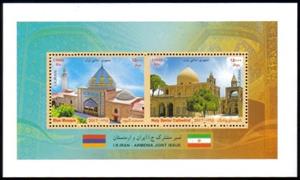Souvenir Sheet: Religious Monuments - Joint Issue With Armenia (Iran 2017)
Religious Monuments - Joint Issue With Armenia (Iran 2017)
01 January (Iran ) within release Religious Monuments - Joint Issue With Armenia goes into circulation Souvenir Sheet Religious Monuments - Joint Issue With Armenia face value 30,000 Iranian rial
| Souvenir Sheet Religious Monuments - Joint Issue With Armenia in catalogues | |
|---|---|
| Stamp Number: | Sn: IR 3178 |
Souvenir Sheet is square format.
Souvenir Sheet Religious Monuments - Joint Issue With Armenia it reflects the thematic directions:
A church building, often simply called a church, is a building used for Christian religious activities, particularly worship services. The term in its architectural sense is most often used by Christians to refer to their religious buildings, but it is sometimes used (by analogy) for buildings of other religions. In traditional Christian architecture, the church is often arranged in the shape of a Christian cross. When viewed from plan view the longest part of a cross is represented by the aisle and the junction of the cross is located at the altar area. Towers or domes are often added with the intention of directing the eye of the viewer towards the heavens and inspiring church visitors. Modern church buildings have a variety of architectural styles and layouts; many buildings that were designed for other purposes have now been converted for church use; and, similarly, many original church buildings have been put to other uses. The earliest identified Christian church was a house church founded between 233 and 256. During the 11th through 14th centuries, a wave of building of cathedrals and smaller parish churches occurred across Western Europe. A cathedral is a church, usually Roman Catholic, Anglican, Oriental Orthodox or Eastern Orthodox, housing the seat of a bishop.
A joint issue is the release of stamps or postal stationery by two or more countries to commemorate the same topic, event or person. Joint issues typically have the same first day of issue and their design is often similar or identical, except for the identification of country and value.Mosquitoes, the Culicidae, are a family of small flies consisting of 3,600 species. The word mosquito (formed by mosca and diminutive -ito) is Spanish and Portuguese for little fly. Mosquitoes have a slender segmented body, one pair of wings, three pairs of long hair-like legs, and specialized, highly elongated, piercing-sucking mouthparts. All mosquitoes drink nectar from flowers; females of some species have in addition adapted to drink blood. The group diversified during the Cretaceous period. Evolutionary biologists view mosquitoes as micropredators, small animals that parasitise larger ones by drinking their blood without immediately killing them. Medical parasitologists view mosquitoes instead as vectors of disease, carrying protozoan parasites or bacterial or viral pathogens from one host to another.


